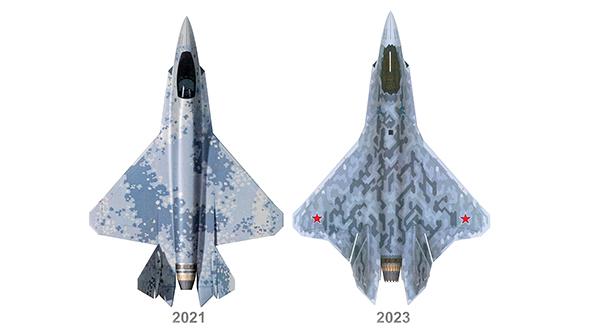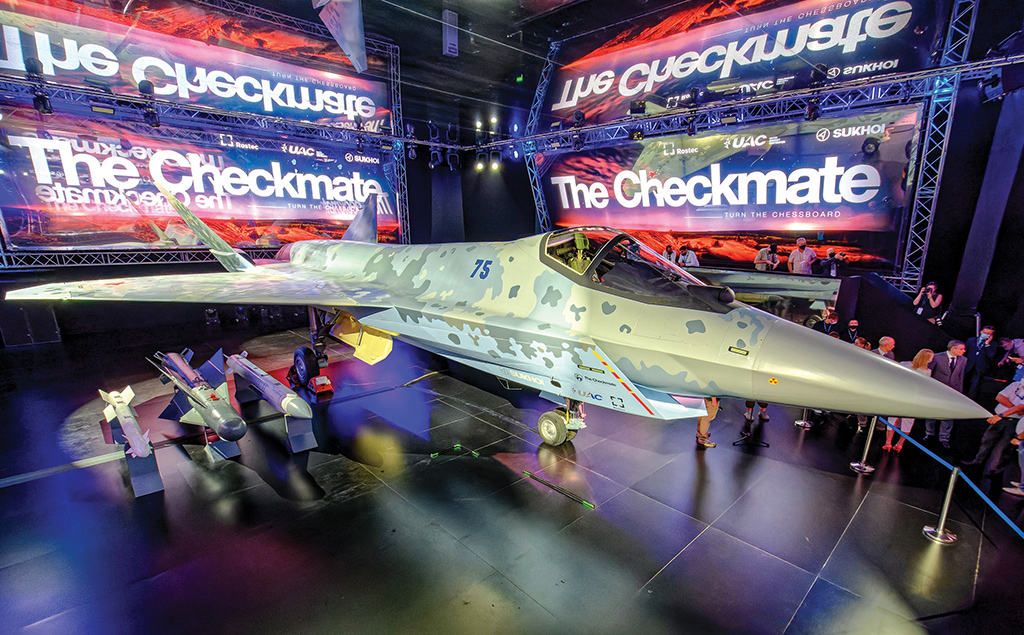
A look at how the Su-75 Checkmate has changed from its 2021 design to the newer version unveiled this year.
In late June, Russia’s Federal Service for Intellectual Property revealed a series of design patents submitted by the Sukhoi Design Bureau showing a new configuration for the Su-75 Checkmate light single-engine stealth fighter; the aircraft designation is not mentioned in the patents. The aircraft’s shape was patented in three versions: a single-seat fighter, two-seat combat trainer and an uncrewed aircraft.
The Su-75 Checkmate was displayed in a full-size mockup in 2021 and in a series of similar patents in 2022. In the new variant, the tail section of the fuselage is changed, the rear wing edge has enlarged flaperons, and the wing leading-edge root extensions are slightly longer. The outer wing panels previously were taken directly from the Su-57; now they have been modified.
- New design likely will delay the fighter’s first flight
- Changes might have been revealed at the MAKS air show
This confirms rumors about changes in the Su-75 design. Sukhoi probably intended to demonstrate the updated Checkmate at the MAKS 2023 air show planned for the end of July, but the show’s cancellation was announced on June 30.
The Sukhoi single-engine fighter was revealed two years ago at MAKS 2021 with the formal designation LTS (Lightweight Tactical Aircraft) and the nickname “Checkmate.” The number “75” painted on the side corresponded to Sukhoi’s internal code T-75, later designated as Su-75. The LTS-M presented at MAKS 2021 was a nonflying demonstrator intended for on-ground synchronization of construction components and equipment. The same aircraft was displayed at the Dubai Airshow in November 2021.
Rework Means Delay
The Sukhoi Design Bureau started detailed design of the Su-75 in early 2020, and the LTS-M demonstrator was completed by the Sukhoi KnAAZ plant in Komsomolsk-on-Amur in May 2021. The same plant is working on the next test aircraft, and future serial aircraft are planned to be produced there.
United Aircraft Corp. CEO Yury Slyusar says two test aircraft are under construction and four will be produced in all. It is unknown if he counted the LTS-M mockup in his total.
The new aircraft are being produced according to the revised design. Slyusar says the use of supercomputers for design sped up development. Compared with classic experiment-based development, supercomputer simulation enables a more rational design in less time and at a much lower cost. Sukhoi says the Su-75 is its first aircraft fully designed on supercomputers.
A significant change in the aerodynamic configuration after the LTS-M mockup was built is likely to delay the program. Even if that adds time, redoing the aircraft at the design stage is more efficient than doing so after several years of flight tests—which is what happened with the Su-27 and Su-57 fighters. Sukhoi intended to conduct full trials on five Su-57 aircraft made in 2010-13. However, after problems with insufficient structural strength became apparent in 2016-17, the design was revised to strengthen the airframe, and another five test aircraft had to be built.
Russian officials do not appear to be in agreement about the timing of the Checkmate program, probably because the company is developing the platform without external procurement and funding and so without imposed deadlines.

During the first aircraft presentation for Russian President Vladimir Putin at MAKS 2021, reports stated that the fighter would make its first flight in 2023. A preproduction batch was to be completed in 2026, and full-scale serial production was to start a year later.
A few months later in Dubai, Slyusar said the corporation intended to accelerate the project and “to start series production in late 2025,” Aviation Week reported at the time (AW&ST Nov. 22-Dec. 5, 2021, p. 18).
On May 18, 2022, Sergei Chemezov, CEO of Rostec Corp. (which includes United Aircraft Corp. and Sukhoi), reported to Putin that the first flight-test aircraft would be completed at the turn of 2023-24, and series production would begin in 2027.
A month later, on June 17, Yuri Borisov, then-Russian deputy prime minister and responsible for the defense industry, said the first flight of the Su-75 was scheduled for 2025. That August, during the Army 2022 exhibition, Minister of Industry and Trade Denis Manturov gave the date 2024 for the start of Su-75 trials.
No Customer
A delay to the Su-75 Checkmate program is not critical because no one is waiting for it anyway. Its greatest challenge is the lack of a firm customer. In July 2021, Chemezov admitted that the fighter is being produced at the company’s own risk, without any orders. A 2021 Checkmate advertising video featured “pilots” from Argentina, India, the United Arab Emirates and Vietnam, signaling Russia’s intended markets.
Russian announcements about possible Su-75 customers have been vague. At the IDEX defense exhibition in Abu Dhabi in February 2017, Russia and the United Arab Emirates signed an agreement to cooperate in the next-generation light fighter project—that was the stimulus that directly pushed the Russians to initiate the Su-75 project. The cooperation never progressed, despite subsequent declarations that it was still valid.
In Dubai in November 2021, a representative of the Russian arms trade service said: “A number of customers have shown heightened interest in this aircraft.” But no specifics followed.
During the February 2023 Aero India air show, the Tass news agency reported that the Russian delegation was discussing possible cooperation with India in the Checkmate project and that the aircraft would be presented at the show. But the aircraft was not displayed there, and it was not mentioned after the show.
The Russian invasion of Ukraine in February 2022 and the resulting geopolitical disruptions significantly limited the number of countries willing to buy Russian military equipment. The Russian Aerospace Forces (VKS) likely would be the first customer for the Su-75. The VKS, with the Su-30SM, Su-35S, Su-57 and MiG-35S multirole fighters and heavy Su-34 fighter-bomber in current production, is not interested in buying another tactical combat aircraft. But the VKS would buy the Su-75 if the political authorities deem it necessary to keep the project alive and support its export.
The Su-75 Checkmate is a single-engine new-generation fighter, which the Russians intended to make at low cost using ready-made components, mostly from the Su-57 fighter—including the same AL-41F-1 engine, as well as much of its systems, avionics and weapons.
Slyusar says the Checkmate will be offered at $30-35 million, while its cost per flight hour is expected to be “six or seven times” less than the Lockheed Martin F-35’s. The Su-75 Checkmate is designed to fly at Mach 1.8 to a range of 2,800 km (1,740 mi.) with internal fuel. Its maximum takeoff weight is 26,000 kg (57,320 lb.) including 7,400 kg of weapons and stores.

Comments
If cheap, it will be a poorly designed and poorly performing fighter and if expensive, no air force will be able to purchase it.
Bernard Guillaume